These TS 10th Class Biology Bits with Answers 9th Lesson Our Environment will help students to enhance their time management skills.
TS 10th Class Biology Bits 9th Lesson Our Environment
Choose the correct answer.
Question 1.
Entry of the pollutants into food chain is. [ ]
A) Bioaccumulation
B) Biomagnification
C) Biomass
D) Biodegradation
Answer:
A) Bioaccumulation
![]()
Question 2.
Among the following pairs, which one is a mis-matched pair.
A) Plant – Producer.
B) Rabbit – Primary consumer.
C) Lion – Carnivore.
D) Giraffe – Secondary consumer.
Answer:
D) Giraffe – Secondary consumer.
Question 3.
The continent without forests ………….
A) Arctic.
B) Asia.
C) Australia.
D) Antarctic.
Answer:
D) Antarctic.
Question 4.
The correct sequence of a food chain ………
A) Plants → Grasshopper → Frog → Snake → Hawk.
B) Plant → Frong → Grasshopper → Hawk Snake.
C) Plant → Hawk → Snake → Frog → Grasshopper.
D) Plant → Snake → Frog → Hawk → Grasshopper.
Answer:
A) Plants → Grasshopper → Frog → Snake → Hawk.
Question 5.
Identify the correct one from the following food chaIns.
A) Eagle → Rat → Snake → Grains.
B) Grains → Rat → Snake → Eagle.
C) Grains → Eagle — Rat → Snake.
D) Rat → Snake → Grains → Eagle.
Answer:
A) Eagle → Rat → Snake → Grains.
![]()
Question 6.
The region of the world of living thing is termed as [ ]
A) Biosphere
B) Ecosystem
C) Food chain
D) Food web
Answer:
A) Biosphere
Question 7.
Which of the following climatic influences determines the terrestiar ecosystem?
A) Rainfall
B) Temperature
C) Light from sun
D) AH the above
Answer:
D) AH the above
Question 8.
The arrows between each item in a food chain always point from [ ]
A) Feeder to food
B) Food to feeder
C) Animals to animals
D) Carnivores to herbivores
Answer:
B) Food to feeder
Question 9.
“Niche”denotes [ ]
A) Animal position in food chain
B) What it eats
C) Its mode of life
D) All the above
Answer:
D) All the above
![]()
Question 10.
Special positions within the food web, in which animals fit in is described as ………………
A) Tropic level
B) Eco level
C) Niche
D) None of the above
Answer:
C) Niche
Question 11.
The concept of Ecological pyramid was first Introduced by [ ]
A) Charles Elton
B) Slobodkin
C) Lindeman
D) Steele
Answer:
A) Charles Elton
Question 12.
First tropic level of a ecological pyramid includes [ ]
A) Producers
B) Primary consumers
C) Secondary consumers
D) Tertiary consumers
Answer:
A) Producers
Question 13.
This pyramid shows the population of organisms at each tropic level in a food chain [ ]
A) Pyramid of biomass
B) Pyramid of number
C) Pyramid of Egypt
D) Pyramid of energy
Answer:
B) Pyramid of number
Question 14.
Pyramid of number does not look like a pyramid when [ ]
A) The producer is a large plant
B) One of the organism at any tropic level is very small
C) In the parasitic food chain
D) All the above
Answer:
D) All the above
![]()
Question 15.
In an aquatic ecosystem, the pyramid of biomass is [ ]
A) Upright
B) Inverted
C) Partly inverted
D) None of the above
Answer:
B) Inverted
Question 16.
This percentage of the biomass is transferred from one tropic level to the next ma food chain [ ]
A) 40 – 50
B) 80 – 90
C) 10 – 20
D) 30 – 40
Answer:
C) 10 – 20
Question 17.
The process of entering of pollutants ma food chain is known as [ ]
A) Biomagnification
B) Bioinfection
C) Bioaccumulation
D) Biological control
Answer:
C) Bioaccumulation
Question 18.
The tendency of pollutants to concentrate as they move from one tropic level to the next is known as [ ]
A) Biomagnification
B) Bioinfection
C) Bioaccumulation
D) Biological spread
Answer:
A) Biomagnification
Question 19.
Which of the following is a secondary consumer in a grassland ecosystem?
A) Grass
B) Frog
C) lnsect
D) Shake
Answer:
C) lnsect
Question 20.
Flow of materials between organisms and their envionment is called [ ]
A) Cycling of materials
B) Mineral circulation
C) Biogeochemical cycles
D) All the above
Answer:
D) All the above
![]()
Question 21.
Among the following pesticides which is less dangerous?
A) DDT
B) Aidrin
C) Dieldrin
D) Heptachior
Answer:
A) DDT
Question 22.
Steps towards prevention from harmful effects [ ]
A) Ban all pesticides
B) Use pesticides with less chemicals
C) Sound biological principles
D) A and C
Answer:
D) A and C
Question 23.
The terrestrial ecosystems are being determined by the variations in [ ]
A) Edaphic factors
B) Climatic factors
C) Environmental factors
D) All the above
Answer:
C) Environmental factors
Question 24.
This shows who eats what is in a particular habitat [ ]
A) Food web
B) Food pyramid
C) Food chain
D) Ecosystem
Answer:
C) Food chain
![]()
Question 25.
In general, when we move from producers to consumers In a food chain the number of organisms at each level
A) Remains constant
B) Decreases
C) Increases
D) First increases later decreases
Answer:
D) First increases later decreases
Question 26.
This is the main source of energy for an ecosystem [ ]
A) Sunlight, Moonlight
B) Bioluminiscence
C) Moonlight
D) Sunlight
Answer:
D) Sunlight
Question 27.
The graphic representation of feeding level structure of an ecosystem by taking the shape of a pyramid is called [ ]
A) Ecological pyramid
B) Environmental pyramid
C) Biospherical pyramid
D) Pyramid if Biomass
Answer:
A) Ecological pyramid
Question 28.
In the ecohgical pyramids, the producers are represented at/in
A) The base
B) The tip
C) The middle
D) All over the pyramid
Answer:
A) The base
Question 29.
In an ecological pyramid top carninvores are represented at the [ ]
A) The base
B) The tip
C) In the middle
D) All over the pyramid
Answer:
B) The tip
Question 30.
In a food chain there is normally increase in ……….. from first-order consumers to the large carnivores.
A) shape
B) size
C) number
D) All the above
Answer:
B) size
![]()
Question 31.
Organic material of biological origin is called [ ]
A) Biomass
B) Bloenergy
C) Biofuel
D) Biogeochemical cycle
Answer:
A) Biomass
Question 32.
Biomass can also be used as [ ]
A) Food
B) Biofuel
C) Biodiesel
D) None of the above
Answer:
B) Biofuel
Question 33.
This pyramid represents the available food as a source of energy at each tropic level in the food chain [ ]
A) Pyramid of numbers
B) Pyramid of biomass
C) Pyramid of energy
D) Pyramid of drymass
Answer:
B) Pyramid of biomass
Question 34.
The pyramid of biomass is inverted in [ ]
A) Terrestrial ecosystem
B) Aquatic ecosystem
C) Forest ecosystem
D) Desert ecosystem
Answer:
B) Aquatic ecosystem
Question 35.
The ratio between energy flows at different tropic levels along the food chain expressed as percentage is called [ ]
A) Ecological deficiency
B) Ecological efficiency
C) Biological deficiency
D) Biological efficiency
Answer:
B) Ecological efficiency
Question 36.
The flow of energy from producers foconsumers is [ ]
A) Unidirectional
B) Bidirectional
C) Tri directional
D) Multidirectional
Answer:
A) Unidirectional
![]()
Question 37.
Bioaccumulation is process of [ ]
A) Entering of pollutants in a food chain
B) Entering of pollutants in a food web
C) Entering of pollutants into an ecosystem
D) Entering of pollutants into bio-sphere
Answer:
A) Entering of pollutants in a food chain
Question 38.
The plant substances which are not digested by most animals are [ ]
A) Cellulose
B) Lignin
C) Carbohydrates
D) Cellulose, lignin
Answer:
D) Cellulose, lignin
Question 39.
In the animal, foods cannot be digested by most animals [ ]
A) Hair, feathers
B) insect exoskeletons
C) Cartilage, bone
D) All the above
Answer:
D) All the above
Question 40.
At each trophic level, organisms use most of the food energy to fulfill their metabolic activities like [ ]
A) Performance of work
B) Growth
C) Reproduction
D) AH the above
Answer:
D) AH the above
Question 41.
Most of the energy in gasoline is lost as …. in a car’s engine rather than being transformed into the energy of motion. [ ]
A) Pressure
B) Heat
C) Water vapour
D) Temperature
Answer:
B) Heat
![]()
Question 42.
The catchement area of the fresh water lake extends upto [ ]
A) 6121 km2
B) 6211 km2
C) 6237 km2
D) 6312 km2
Answer:
A) 6121 km2
Question 43.
When did Government of India had declared the Kolleru lake as Bird sanctuary? [ ]
A) In October, 1999
B) In November, 1999
C) In December, 1999
D) In September, 1999
Answer:
B) In November, 1999
Question 44.
Kolleru lake attracts migratory birds from Asia and Eastern Europe of about birds per year. [ ]
A) 15,00,000 birds
B) 35,00,000 birds
C) 20,00,000 birds
D) 25,00,000 birds
Answer:
C) 20,00,000 birds
Question 45.
The length of twisty channel lipputeru which connects Kolleru lake with Bay of Bengal [ ]
A) 75km
B) 65km
C) 55km
D) 80km
Answer:
B) 65km
Question 46.
Excessive nutrient addition, especially from anthropogenic sources, led to extensive growth of the following need in Kolleru lake [ ]
A) Ipomea
B) Eichornia
C) Cyperus
D) Cynodactylon
Answer:
B) Eichornia
![]()
Question 47.
These water-borne diseases are common among the inhabitants of Kolleru lake [ ]
A) Diarrhoea
B) Typhoid
C) Amoebiasis
D) All the above
Answer:
A) Diarrhoea
Question 48.
The bio – accumulated components of pesticides which entered the food chain are [ ]
A) Mercury
B) Arsenic
C) Lead
D) All the above
Answer:
D) All the above
Question 49.
Fish are considered to be the bio indicators of meta I contamination in environmental monitoring because [ ]
A) They are strongly respond to stress conditions
B) They do not strongly respond to stress conditions
C) They are weak in respond to stress conditions
D) They easily adjust to stress conditions
Answer:
A) They are strongly respond to stress conditions
![]()
Question 50.
The metal which was bio-accumulated in liver, gill and kidney of Edulabad water reservoir in Adilabad district ……………
A) Cadmium
B) Nickel
C) Chromium
D) Iron
Answer:
A) Cadmium
Question 51.
The bioaccumulation of heavy metals into human being through food cause disease like [ ]
A) Hypertension
B) Sporadic fever
C) Renal damage, Nausea
D) All the above
Answer:
D) All the above
Question 52.
Minamata disease was caused by release of ………. in industrial waste water in Japan.
A) Methyl mercury
B) Ethyl mercury
C) Acetic acid
D) All the above
Answer:
A) Methyl mercury
Question 53.
In the entire history of sparrows around the world, in this country, they were hunted down in 1958. [ ]
A) Japan
B) China
C) Indonesia
D) Thailand
Answer:
B) China
![]()
Question 54.
Fossil fuels are formed by Anaerobic decomposition of buried [ ]
A) Dead organisms
B) Coal
C) Petrol
D) All the above
Answer:
D) All the above
Question 55.
Sujata says “To keep our surroundings clean, we should cut all the trees grass, etc. and plant trees according to our will and wish “. Rafi rejects her opinion because [ ]
A) It is highly expensive
B) It is time consuming
C) It hampers sustainability
D) It becomes an artificial set up
Answer:
C) It hampers sustainability
Question 56.
The primary consumer in the food chain comprising of a snake, insect, frog and grass is [ ]
A) Grass
B) Frog
C) Insect
D) Snake
Answer:
C) Insect
Question 57.
In an ecosystem consumers are divided on the basis of factors [ ]
A) Energy
B) Tropic level
C) Consumed food, tropic level
D) Consumed food
Answer:
D) Consumed food
![]()
Question 58.
Kolleru lake was declared as Bird Sanctuary in the year [ ]
A) 1999
B) 1989
C) 2009
D) 1998
Answer:
A) 1999
Question 59.
The birds which were hunted to a great extent in 1958 in China [ ]
A) Eagles
B) Sparrows
C) Crows
D) Hawks
Answer:
B) Sparrows
Question 60.
The physical factors refer to abiotic factors like [ ]
A) land and water
B) air
C) sunlight
D) all the above
Answer:
D) all the above
Question 61.
As we move from producer to consumer in a food chain numbers of organisms [ ]
A) increase
B) decrease
C) same
D) none of the above
Answer:
B) decrease
Question 62.
The disease caused by the accumulation of heavy metals into human beings through food [ ]
A) Hypertension
B) Sporadic fever
C) Renal damage, Nausea
D) All the above
Answer:
D) All the above
Question 63.
Methyl mercury causes a disease [ ]
A) Jaundice
B) Typhoid
C) Minamata
D) None
Answer:
C) Minamata
![]()
Question 64.
The name of the weed grown excessively in Kolleru lake is [ ]
A) Cyperus
B) Eichornia.
C) Ipomea
D) Cynoclactylon
Answer:
B) Eichornia.
Question 65.
The major sources of pollution in Kolleri [ ]
A) Agricultural runoff of agrochemicals, fertilizers
B) Fish tank discharges
C) Municipal and domestic sewage
D) All the above
Answer:
D) All the above
Question 66.
The water-borne diseases are [ ]
A) Diarrhoea
B) Typhoid
C) Amoebiasis
D) All the above
Answer:
D) All the above
Question 67.
Coniferous forest belongs to [ ]
A) Terrestrial ecosystem
B) Aquatic ecosystem
C) Both A and B
D) Mountains
Answer:
A) Terrestrial ecosystem
Question 68.
A serious risk for survival of aquatic organisms is due to [ ]
A) Excessive nutrient input
B) Acidification, organic pollutants
C) Heavy metal contamination
D) All the above
Answer:
D) All the above
Question 69.
Plants : Producers :: Frog: …..?….
A) Primary Consumer
B) Secondary Consumer
C) Tertiary Consumer
D) Top tarnivore
Answer:
B) Secondary Consumer
Question 70.
Identify the mismatched pair ……… [ ]
1) MIC — Bhopal
2) Methyl Mercury — India
3) Non-biodegradable — Compost
A) 1,2
B) 1,3
C) 2 only
D) 2,3
Answer:
D) 2,3
Question 71.
Arrange the food chain in the correct order [ ]

A) 2, 4, 5, 3, 1
B) 1, 4, 5, 2, 3
C) 2, 5, 4, 3, 1
D) 2, 4, 5, 1, 3
Answer:
D) 2, 4, 5, 1, 3
![]()
Question 72.
Which one of the following acts asprimary as well as secondary consumer in the forest ecosystem? [ ]
A) Rabbit
B) Deer
C) Tiger
D) Man
Answer:
Question 73.
Example for non-biodegradable pesticide [ ]
A) B.H.C
B) D.D.T
C) Aidrin
D) All the above
Answer:
D) All the above
Question 74.
This is an example for pyramid of biomass of …….. [ ]

A) Forest ecosystem
B) Desert ecosystem
C) Grassland ecosystem
D) Aquatic ecosystem
Answer:
D) Aquatic ecosystem
Question 75.
One of the following is not a consumer [ ]
A) Deer
B) Kangaroo
C) Dolphin
D) Diatoms
Answer:
D) Diatoms
Question 76.
Arrange this flowchart in the correct order. [ ]

A) 1, 3, 2, 4, 5
B) 1, 3, 4, 2, 5
C) 3, 1, 2, 4, 5
D) 3, 2, 1, 4, 5
Answer:
D) 3, 2, 1, 4, 5
![]()
Question 77.
Match the following.
List-A —- List-B
1. Kolieru bird [ ] a) D.D.T sanctuary
2. Bio [ ] b) Desert magnification ecosystem
3. Xerophytic [ ] c) 1999 plants
A) 1 – c, 2 – b, 3 – a
B) 1 – b, 2 – c, 3 – a
C) 1 – a, 2 – b, 3 – c
D) 1 – c, 2 – a, 3 – b
Answer:
D) 1 – c, 2 – a, 3 – b
Question 78.
In the above food chain, fish occupies [ ]

A) 1st trophic level
B) 2nd trophic level
C) 3rd trophic level
D) 4th trophic level
Answer:
C) 3rd trophic level
Question 79.
Which of the following has much accumulation of pollutants in this pyramid? [ ]
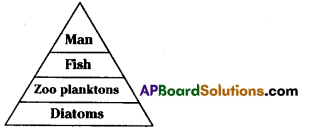
A) Diatoms
B) Zooplanktons
C) Fish
D) Man
Answer:
D) Man
Question 80.
Observe the food chain. [ ]

A) 15 kJ
B) 20 kJ
C) 10,000 KJ
D) 0.1 kJ
Answer:
D) 0.1 kJ
Question 81.
Grass → Deer → Tiger
The ‘ → ‘ mark in the above food chain aways points from [ ]
A) Feeder to food
B) Food to feeder
C) Carnivores to herbivores
D) None of the above
Answer:
B) Food to feeder
![]()
Question 82.
Complete this flowchart. [ ]
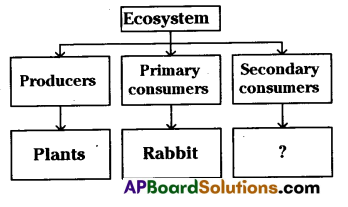
A) Elephant
B) Snake
C) Wolf
D) Frog
Answer:
C) Wolf
Question 83.
This trophic level is occupied by [ ]

A) Herbivores
B) Carnivores
C) Plants
D) Decomposers
Answer:
B) Carnivores
Question 84.
This pyramid shows the grassland ecosystem. All the trophic levels are completely destroyed. What might have happened to this ecosystem? [ ]
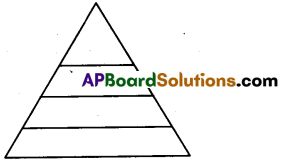
A) Herbivores are completely removed
B) Carnivores are completely removed
C) Producers are completely removed
D) None of the above
Answer:
A) Herbivores are completely removed
Question 85.
Ecosystem : Tansley : : Ecological pyramid : ……?…………
A) Lindeman
B) Elton
C) Slobodkin
D) None
Answer:
B) Elton
Question 86.
Read the following statements.
a) The flow of energy from producers to consumers in an ecosystem is unidirectional
b)The ecological pyramids, producers are placed at the top.
A) Both a, b false
B) Both a, b correct
C) a false, b correct
D) a correct, b false
Answer:
D) a correct, b false
Question 87.
This factor shows major impact on the ecosystem. [ ]
A) Sunlight
B) Temperature
C) Rainfall
D) All the above
Answer:
D) All the above
Question 88.
This pyramid represents …………

A) Pyramid of biomass
B) Pyramid of numbers
C) Pyramid of energy
D) None of the above
Answer:
B) Pyramid of numbers
![]()
Question 89.
In the above food chain, this represents the second trophic level [ ]
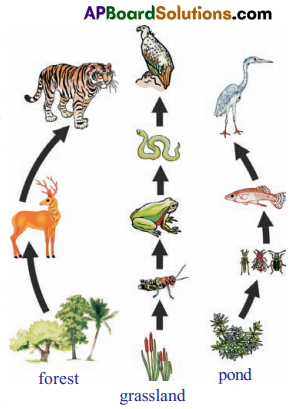
A) Tiger
B) Tree
C) Fish
D) Deer
Answer:
D) Deer
Question 90.
In the above food relationship, which one represents the secondary consumer? [ ]
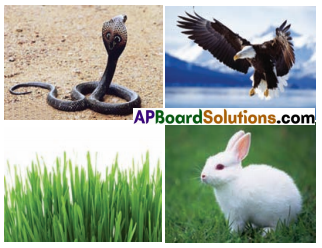
A) Grass
B) Snake
C) Rabbit
D) None of them
Answer:
B) Snake
Question 91.
This flow chart represents [ ]

A) The pyramid of energy
B) The pyramid of biomass
C) The pyramid of numbers
D) None of the above
Answer:
B) The pyramid of biomass
Question 92.
This figure represents the following.
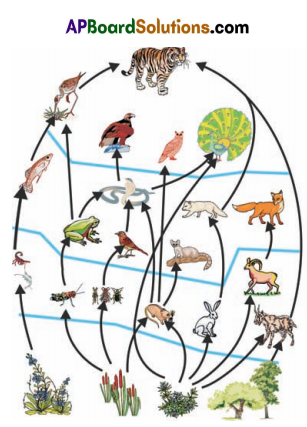
A) Pyramid of energy
B) Food web
C) Pyramid of numbers
D) None of the above
Answer:
B) Food web
![]()
Question 93.
What is the heavy metal that accumulated in higher quantities In the liver, gills and kidney of fish in Edulabad WaterReservoir
A) Chromium
B) Lead
C) Nickel
D) Cadmium
Answer:
D) Cadmium
Question 94.
This photograph tells us about [ ]
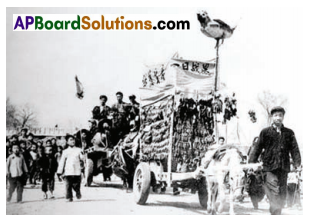
A) Green revolution
B) Blue revolution
C) White revolution
D) Sparrow Campaign
Answer:
D) Sparrow Campaign
Question 95.
What percent of energy loss can be observed at each trophic level? [ ]
A) 90%
B) 70%
C) 60%
D) 10%
Answer:
D) 10%
Question 96.
The flow of energy in a food chain is minimum at [ ]
A) Herbivores
B) Primary consumers
C) Producers
D) Top carnivores
Answer:
D) Top carnivores
Question 97.
If the energy available at the producer level in a food chain is 200J, how much energy will be! available at the tertiary consumer level?
A) 20 J
B) 2 J
C) 0.2 J
D) 200 J
Answer:
C) 0.2 J
![]()
Question 98.
If the energy available at tertiary consumer level is 20J in a food chain, how much energy will be available at the primary consumer level? (10% Law)
A) 2000 J
B) 1000 J
C) 200 J
D) 20 J
Answer:
A) 2000 J